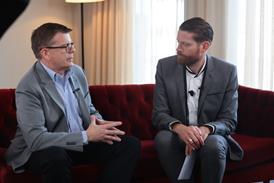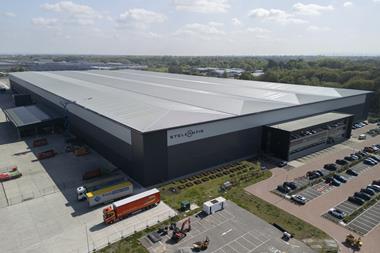 Hail poses obvious risks for finished vehicles left out unprotected but there are various steps that can be taken to address the problem – some of them based on prevention and others based on cure
Hail poses obvious risks for finished vehicles left out unprotected but there are various steps that can be taken to address the problem – some of them based on prevention and others based on cure
The risk of hail damage when storing or moving vehicles out in the elements can be a big issue for carmakers and logistics companies, with some regions of the world particularly prone to damage.
In this story...
The fact that large numbers of vehicles are often consolidated at ‘pinch points’ between different modes of transport, or stored pending customer orders, makes the risk of weather-borne incidents – whether hail, sand, ice, flood or pollution – a particular concern.
Besides the obvious inconvenience caused by hail damage, there is also a significant cost implication. According to Timothy Doonan, senior vice-president, marine claims division at Tokio Marine Claims Service, which insures major Japanese OEMs globally, hail losses represented “more than 50% of all large losses” in the most recent five-year insurance cycle. This has led the company to place increased emphasis on identifying high-risk locations and high seasons for hail, and correlating this with its OEM clients’ locations to devise improved loss prevention recommendations.
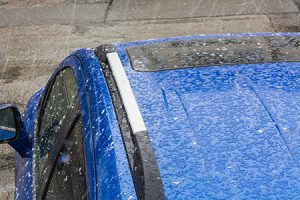
According to the National Insurance Crime Bureau (NICB) National Loss Data in the US, the hail season in America runs from March to September, with May, June, April and March the worst months. Particularly vulnerable to hail damage are Texas, Colorado, Nebraska and Kansas, it suggests, followed by Illinois, Oklahoma, Missouri, Minnesota, South Dakota and Indiana. Early in 2016, hail became so severe in Texas that it even shut a Toyota plant in San Antonio for a short while.
In Europe, James Sadlier, director at damage claims analyst Sevatas, points out that the likelihood of regular hail is still relatively low compared to other parts of the world. That said, there has been a change in recent years. While southern Europe had more often been prone to hail during warmer months, more recently there have been significant events in northern Europe – in 2014 and 2016, particularly – in large northern European markets like Germany and the UK.
[sta_anchor id="1"]However, the unexpected can and often does happen, and at the end of November, a hailstorm in Valencia, Spain damaged thousands of vehicles – an unusual event for the time of year.
Dealing with bent metalIn trying to manage the problem, firms have generally turned to hail damage repair companies, which offer a wide range of services aimed at fixing problems in situ. Some plants, such as the new Audi site at San José Chiapa in Mexico, as well as Volkswagen’s factory in Chattanooga, Tennessee, also use hail nets in the vehicle yard to physically prevent such damage. Other companies and sectors are even using so-called ‘hail cannons’ that are claimed to disperse hail before it can form.
As with all damage scenarios, organisations responding to the risks posed by hail must choose between trying to avoid danger altogether and trying to address it once it has occurred. Whichever way they go, they need to look for a solution that is cost-effective and expedient, if they are to avoid delays that lead to customer dissatisfaction.
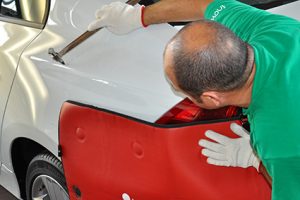 Paintless dent repair provider Inova Autoservices technician at work; Inova MD Ivan Giai Via suggests less than 30% of PDR technicians could be considered truly qualified for work on new vehicles
Paintless dent repair provider Inova Autoservices technician at work; Inova MD Ivan Giai Via suggests less than 30% of PDR technicians could be considered truly qualified for work on new vehiclesUntil recently, repairing damage has been the favoured choice among many insurers and OEMs, but the sporadic and unpredictable nature of hail damage means it is unlikely such firms will have in-house specialists truly capable of dealing with such catastrophes.
This has led to the development of a growing hail repair sector comprised of companies committed to the resolution of hail damage using increasingly sophisticated methods. Such services often include a wide range of activities, from the establishment of a mobile field office, inventory checks, damage inspection and transport to parts ordering, paintless dent repair (PDR) and the provision of quality control light tunnels.
One company in this field is German-headquartered UniCar, which runs a dedicated team from its Spanish subsidiary that can travel to a hail damage site at short notice and represent its client in assessing vehicles before determining those that are undamaged, those that can be moved and repaired by the retail dealer, and those that will need professional repair in situ.
According to Mark Morgan, director of business development at UniCar, the key recent development among established service providers in the sector has been the application of techniques to repair some of the more serious damage that could not previously have been addressed successfully.
[sta_anchor id="2"]“Such techniques have meant vehicles that would have previously been written off and scrapped can now be recovered, even back to a nearly-new-car standard, saving significant cost in the process. A further development has been in the IT used to manage the ordering of spare parts and manage the repair process in the most effective manner,” he says.
‘Shakeout’ in the PDR sectorDespite this rise, Fabio Vigna, managing director at UK repair services provider AutomotionTech (AMT), suggests that the PDR sector in Europe is currently experiencing “a shakeout phase” as new companies, prepared to charge lower prices at the expense of quality, continue to enter the sector.
“A lot of [repair] technicians are arriving from outside Europe, either ‘regularly’ or ‘irregularly’, and changing the physiognomy of the market,” he says. “However, we remain positive about the future – I see many opportunities we still need to explore. Investments in developing new technologies, IT and a more integrated service are the only way to overcome the challenges.
“Repairing hail damaged cars is not enough any more. Our clients are looking for a reliable partner that is able to ‘solve a problem’ and handle a complete project,” he adds.
"Repairing hail damaged cars is not enough any more. Our clients are looking for a reliable partner that is able to ‘solve a problem’ and handle a complete project." - Fabio Vigna, AutomotionTech
Carlos Sanjuan, executive director at UniCar Spain, agrees that specialist damage repair companies “cannot survive purely on weather-based work, even if such jobs can sometimes last for many months at a time”. As a result, he observes, many companies are now branching out into repairs for other clients, like dealer networks, in an effort to secure a more regular income stream.
While Europe may be seeing some new players undercutting the market, Sanjuan suggests the region could struggle to find reliable specialists in future. “We also see these companies expanding their geographical reach outside Europe, which could impact on future capacity availability,” he says.
While repair specialists aim to be mobile, it is not always easy to legally access every market. Carlo Travaglini, key account manager at Ballsystem – an Italian-based company that operates in the field of smart repair technologies – points out that trade and customs restrictions are often a barrier to firms seeking to expand their operations worldwide. He believes the best strategy for PDR companies is to “think globally but act locally”, including working with local companies and specialists, especially when operating across European borders.
“Of course PDR companies must also always look at the changes in supply chain, logistics and IT and try to give to customers tailored solutions in line with the changes happening in the automotive sector,” he adds.
Ivan Giai Via, managing director at Swiss-based PDR provider Inova Autoservices, points out that compared to ten years ago, the emergence of a large number of PDR companies, coupled with their rapid expansion across a worldwide base, has minimised the need for firms to move technicians around internationally; local technicians are present in almost every country.
Even so, he suggests that less than 30% of PDR technicians could be considered qualified for working on new vehicles, including meeting carmakers’ exacting standards. That is why the largest insurers and manufacturers have a list of preferred suppliers. Plus, while demand for foreign manpower is likely only in specific cases, there are countries where labour restrictions can cause issues.
[sta_anchor id="3"]“The difficulties of obtaining visas or permits to work in countries such as the US or Australia represent a limit for the major companies in Europe, which could supply their [repair] services in cases where volumes exceed the capacity local companies’ technicians are able to offer,” he says.
All hail the net?As well as relying on dent repair, some companies are also exploring the potential of tools and techniques designed to prevent hail damage before it occurs. In some parts of the world, notably in parts of western Europe, multi-storey parking facilities can offer a solution. According to Morgan of UniCar, however, the support posts in such structures “add to the damage risk profile during movement”. In North America, meanwhile, such covered buildings are very rare.
Another prevention method is to put up hail nets at storage or transit facilities, including truck haulaway zones and outbound rail loading bays. “Vehicles staged outside of nets will require PDR repair should a hail event occur, with overall mitigation of loss and less disruption to the flow of new vehicle delivery,” says Tim Doonan.
 Nets and canopies physically prevent hail from reaching vehicles but restrict parking and manoeuvring space
Nets and canopies physically prevent hail from reaching vehicles but restrict parking and manoeuvring spaceDespite the obvious benefits, he adds that the cost of hail net construction for an entire storage inventory can be prohibitive. The nets can also lead to lost parking space because of their structural supports, and may increase the chance of damage from collisions. The need for ongoing maintenance of such structures and the management of snow loads also incur costs.
“Insurers and manufacturers need to improve risk management decisions by making more compelling arguments for prevention, and collaborate to learn the critical financial tipping point to invest in hail net protection,” says Doonan. “What other factors are involved in the decision to construct hail nets, and how can hail net construction costs be minimised or subsidised?”
Hail nets also generate a risk in themselves, says Sanjuan of UniCar Spain. “In many cases, the size and intensity of the hail can cause the collapse of the net, damaging the cars underneath worse than the hail itself,” he explains.
A well calculated cover-upHail canopies are another prevention system that has gained some traction in recent years. One prominent provider is Dallas, Texas-based USA Shade and Fabric Structures, which provides permanent, steel-framed, HDPE plastic and cable-tensioned systems for hail protection throughout hail-prone areas of North America.
According to senior vice-president Wade White, the system “effectively acts as an outdoor building, preventing hail from damaging vehicles beneath the HDPE fabric”. Because the fabric is mesh, it allows diffused light to pass through from high-mast lights, eliminating the need for additional lighting.
In Europe, some OEMs have made novel partnerships with local power utility companies in which the latter undertake to maintain and draw power from solar panels located on the OEM’s site, while the OEM gets free hail protection if it stores vehicles underneath them, says Doonan.
“We will have to explore if there are [other] partnerships to be developed in ports or OEM manufacturing plants to take advantage of synergistic programmes for shared use and benefit,” he comments.
Generally speaking, though, James Sadlier of Sevatas suggests hail damage prevention is difficult since it is hard to predict risks. That said, he admits that climate change will inevitably impact where hail occurs, with current trends showing it increasingly affecting northern Europe, as well as the more commonly hit warmer climates of southern Europe. “Justifying infrastructure costs is not easy based upon historical data in Europe and, although [sta_anchor id="4"]monitoring and measurement is increasingly accurate, it is only at the time the hail presents itself. Thunderstorms are the best tracking measure of likely hail, but as hail is localised within the storm area, it is impossible to predict exactly where it will fall,” he says.
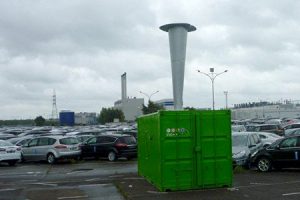 Hail cannons send out a shockwave designed to stop hail from forming but are unsuitable for use in residential areas
Hail cannons send out a shockwave designed to stop hail from forming but are unsuitable for use in residential areasA shocking sounding solutionBeyond hail nets and canopies, some companies are pushing the boundaries even further with the development of hail cannons. One such company is Belgian outfit inopower, which has created a device it claims is capable of generating sonic shockwaves that encourage storm clouds to disperse.
According to owner Marnix van Praet, the shockwave works by influencing the electrical charge of thunderstorm clouds and mixing hot and cold air in the vicinity, in the process reducing the severity of storms.
“The device is portable and quick to install. It stops lightning 95% of the time and stops hail 85% of the time. Applying radar also improves the result,” he says.
However, despite a steady increase in interest, hail cannons have not yet proven to be effective across the sector as a whole. In Tim Doonan’s view, this is at least partially because they cause sonic booms that are unacceptable in populated areas.
Although Morgan of UniCar concedes the solution is less expensive than a net in terms of costs of operation and maintenance, he agrees that the noise pollution is a problem, while suggesting that there is still limited scientific evidence of its effectiveness. Hail cannons are furthermore of little use on hail that has already formed.
“An anti-hail cannon that starts when the hail storm is just above will have very little effectiveness. The various manufacturers of cannons on the market advise starting their equipment against hail about 15 minutes before the first hail falls – and this is unpredictable,” he says. “Therefore, it is advisable to use this protection system with a detection solution such as a weather radar or via subscription to a meteorological service.”
Elsewhere, in an indication of the type of sophisticated technological solutions that might be available in the future, Ivan Giai Via of Inova suggests some companies are now deploying aeroplanes equipped with chemicals like silver iodide capable of ‘neutralising’ clouds with a large hail potential. Such ‘cloud seeding’ methods are designed to prevent hail particles from growing big enough to fall.
[sta_anchor id="5"]Although there are signs that such an approach could become popular in the long term, Sanjuan of UniCar Spain warns that positioning devices below clouds with heavy metals is not a “feasible solution”. This is particularly so in the absence of any evidence of improved results compared with other preventative approaches, he suggests.
 Development and use of state-of-the-art technology is a must for repair service providers wishing to stay ahead of the game, suggests Morgan of UniCar
Development and use of state-of-the-art technology is a must for repair service providers wishing to stay ahead of the game, suggests Morgan of UniCarPrevention or cure?Giai Via says that, taken together, the various damage prevention solutions do pose a threat to the PDR sector, because as their use spreads and the number of vehicles damaged by hail subsequently falls, the market for those companies focused solely on repair will dwindle.
That said, Tim Doonan argues there is not yet much appetite among OEMs in North America to invest in hail nets, even in locations known to be at risk – though he does report seeing more nets being constructed in Mexico. As a result, he suggests, pre-arranged preferred PDR provider agreements will “continue to play the most important role in the vehicle logistics supply chain over the next five years”.
Nevertheless, Doonan acknowledges that continuing efforts from the prevention camp could start to bear fruit. “Insurers are investing in alternatives, such as protective bubble-wrap adhesive transit film to absorb the impact of hail and mitigate damage, although labour and manufacturing costs per unit are still to be determined after trials,” he says. “Targeted application for units in transit to, or in storage in, ‘high-risk’ hail locations may make this alternative cost-effective.”
Mark Morgan of UniCar also recognises the potential of some preventative measures. “Meteorological drones that can warn of local conditions of maximum risk and automatically give the order to cover the maximum area by means of mobile or inflatable structures, such as huge thin airbags, have also been proposed,” he says.
However, Morgan believes major improvements in hail prevention techniques can only come about after “a serious and systematic study of both internal and external prevention factors”. In the meantime, he suggests the development of state-of-the-art technology is “absolutely necessary” for repair service providers wishing to stay ahead of the game, arguing that the entire sector must invest in IT “to ensure it optimises its efficiencies”.
“This requires significant investment but can be justified as manufacturers and insurers begin to expect this higher level as the new standard when hiring a company to handle a catastrophe,” he concludes.






